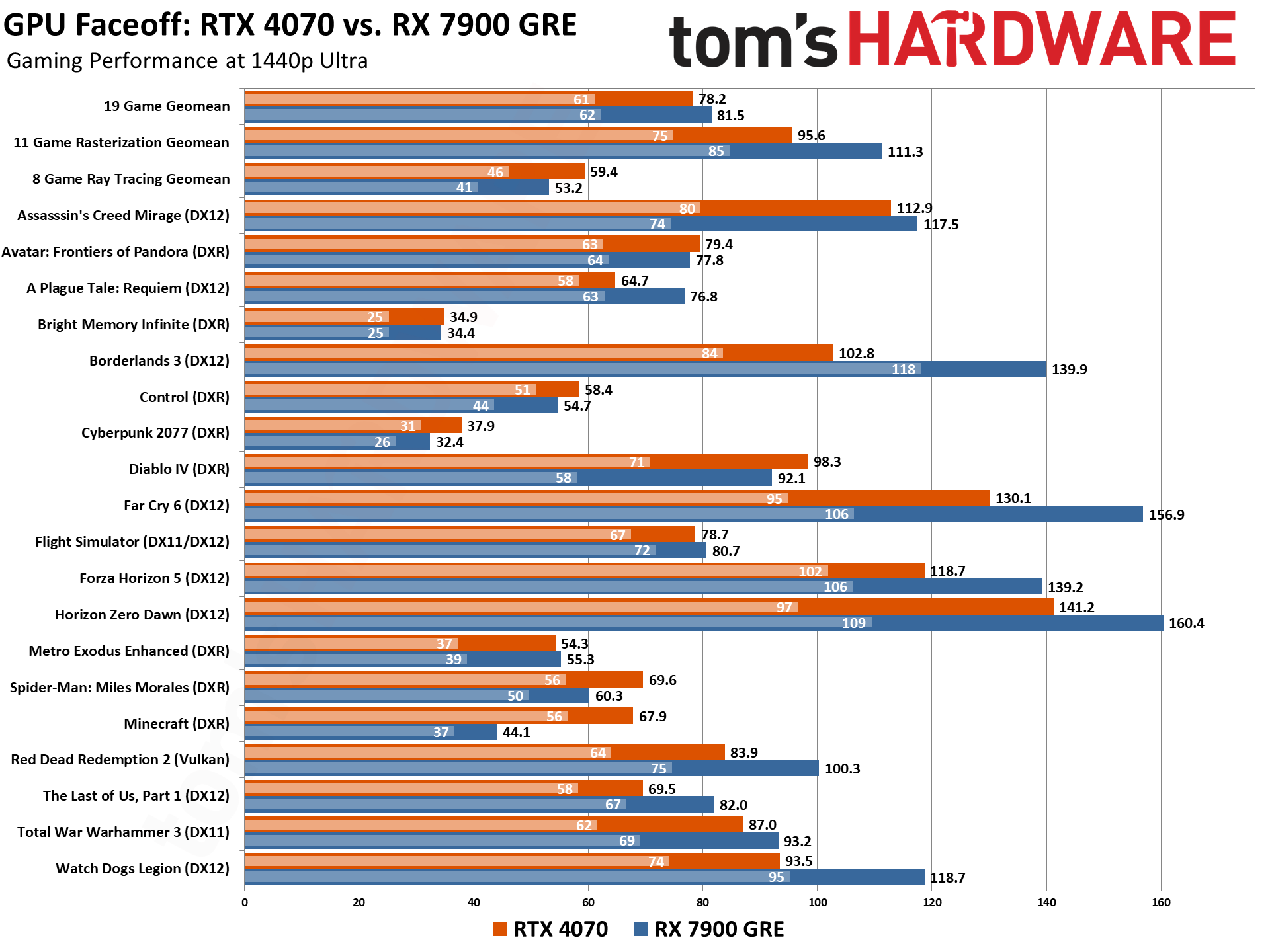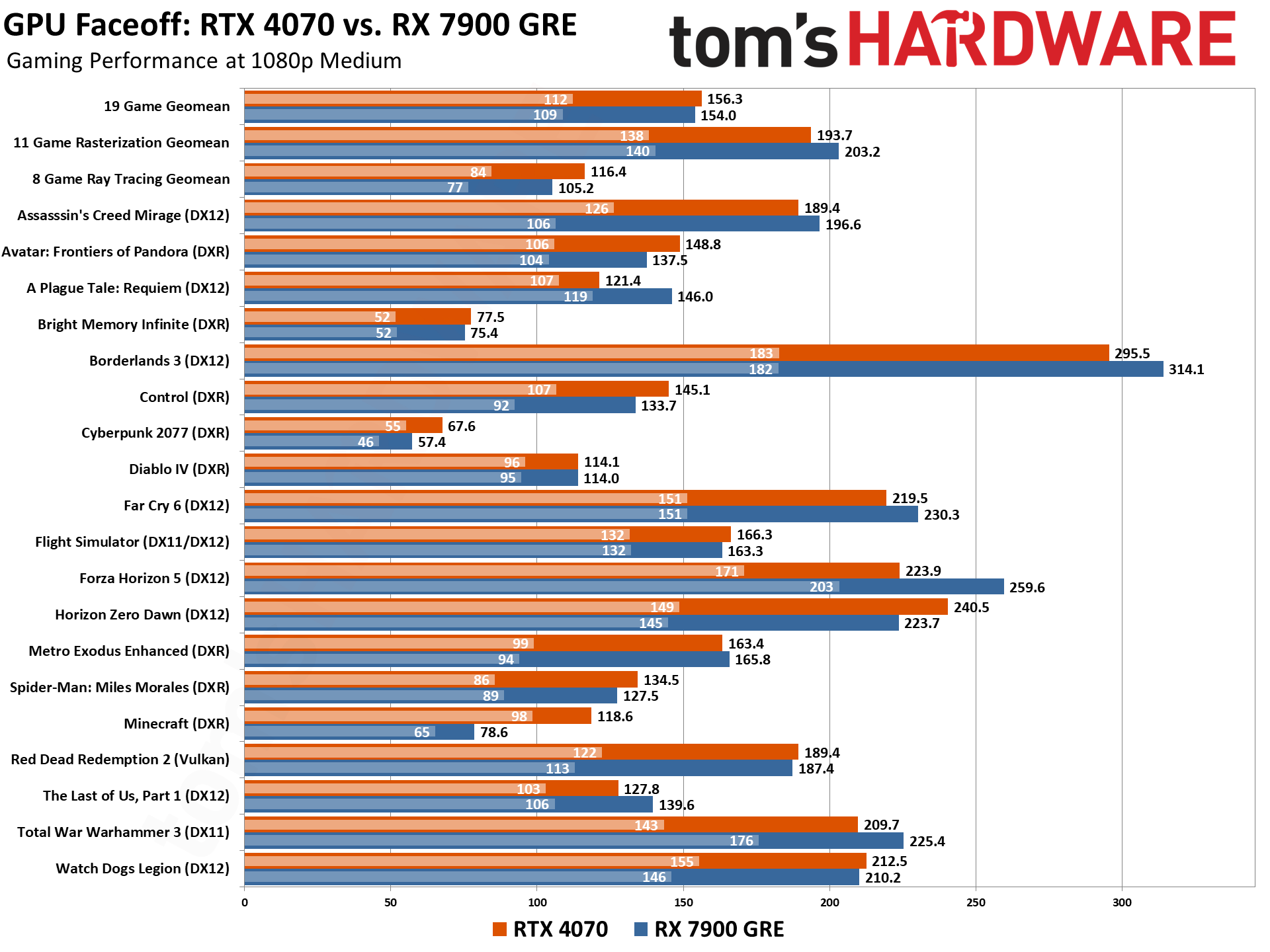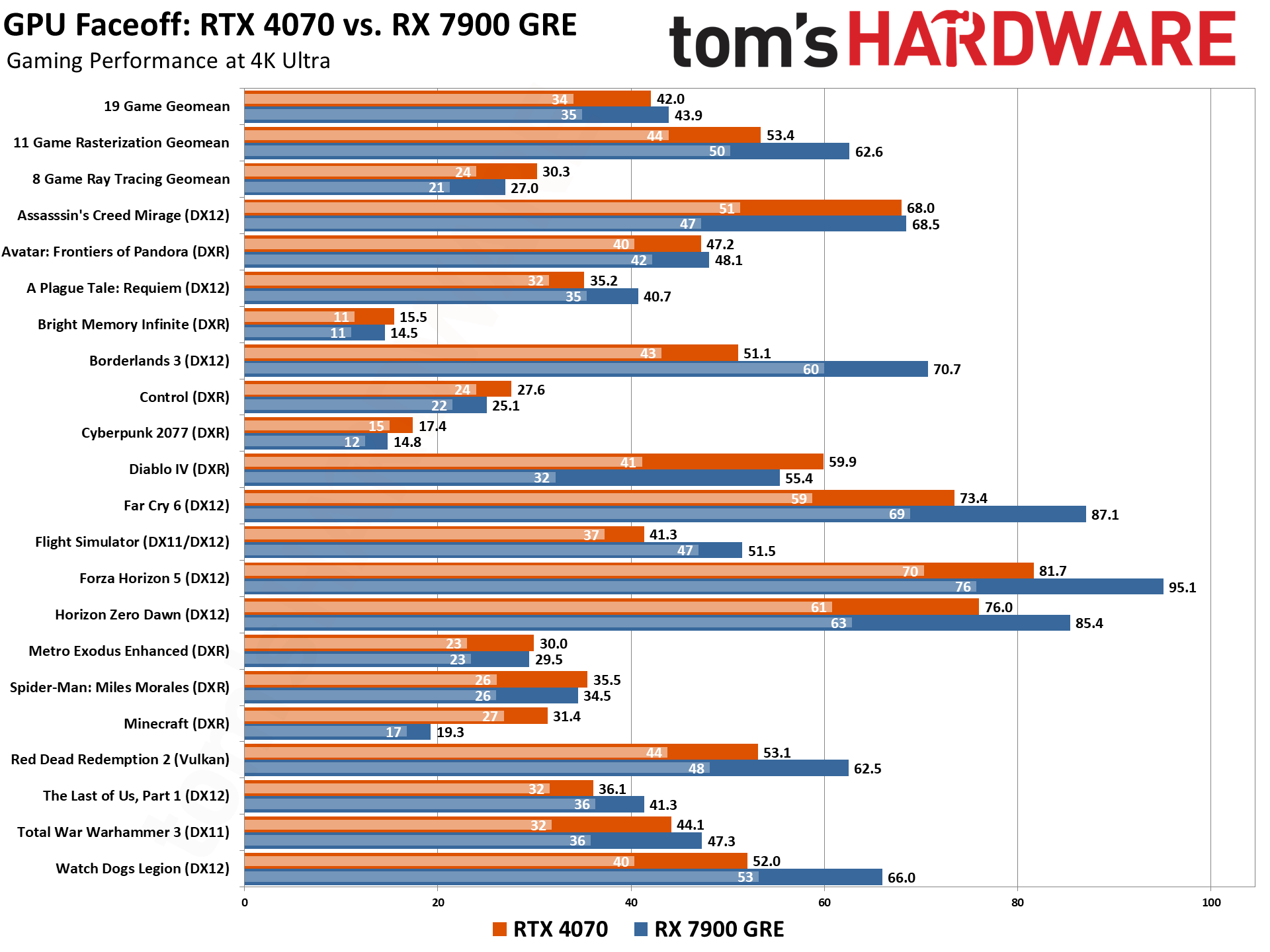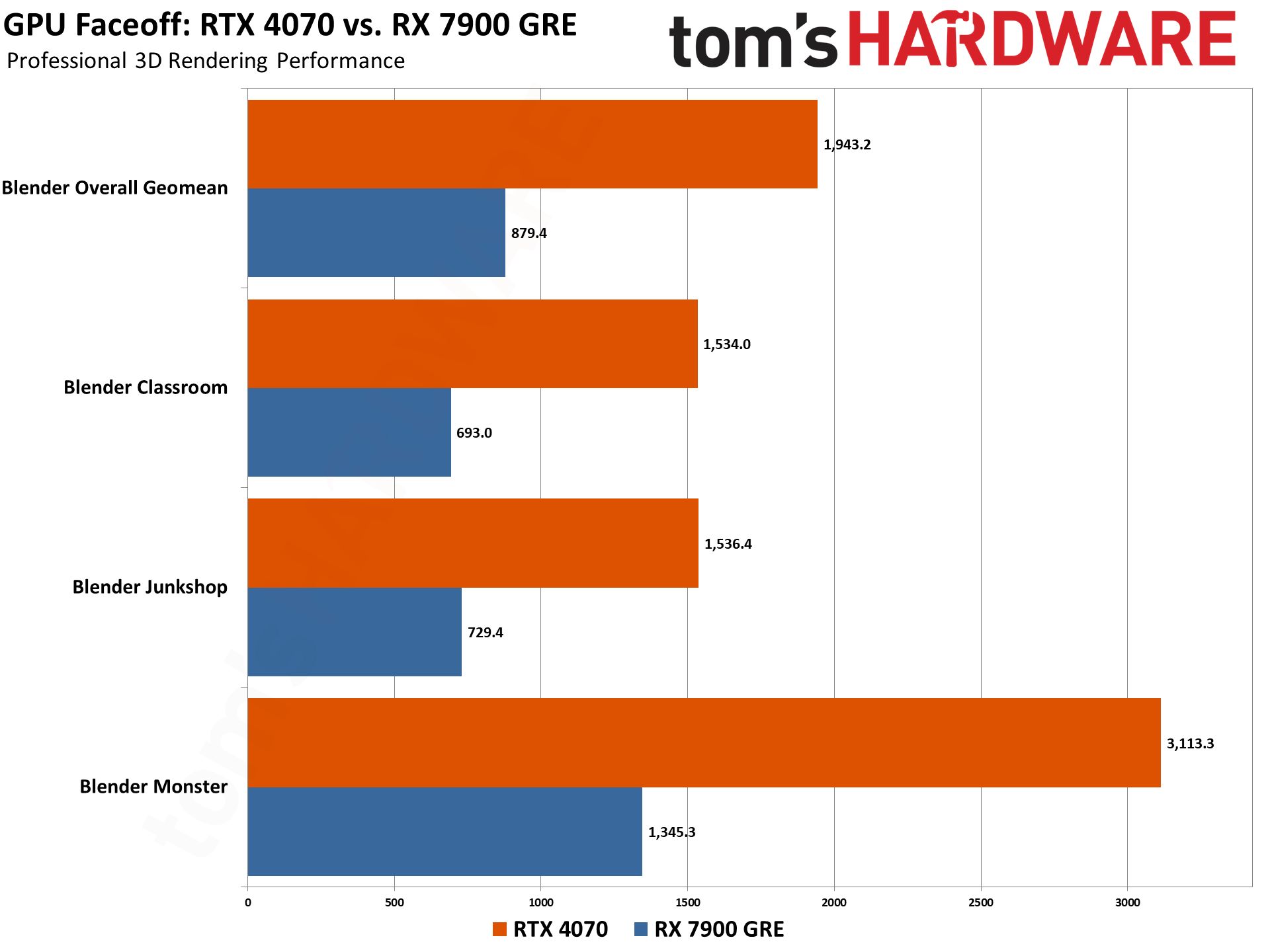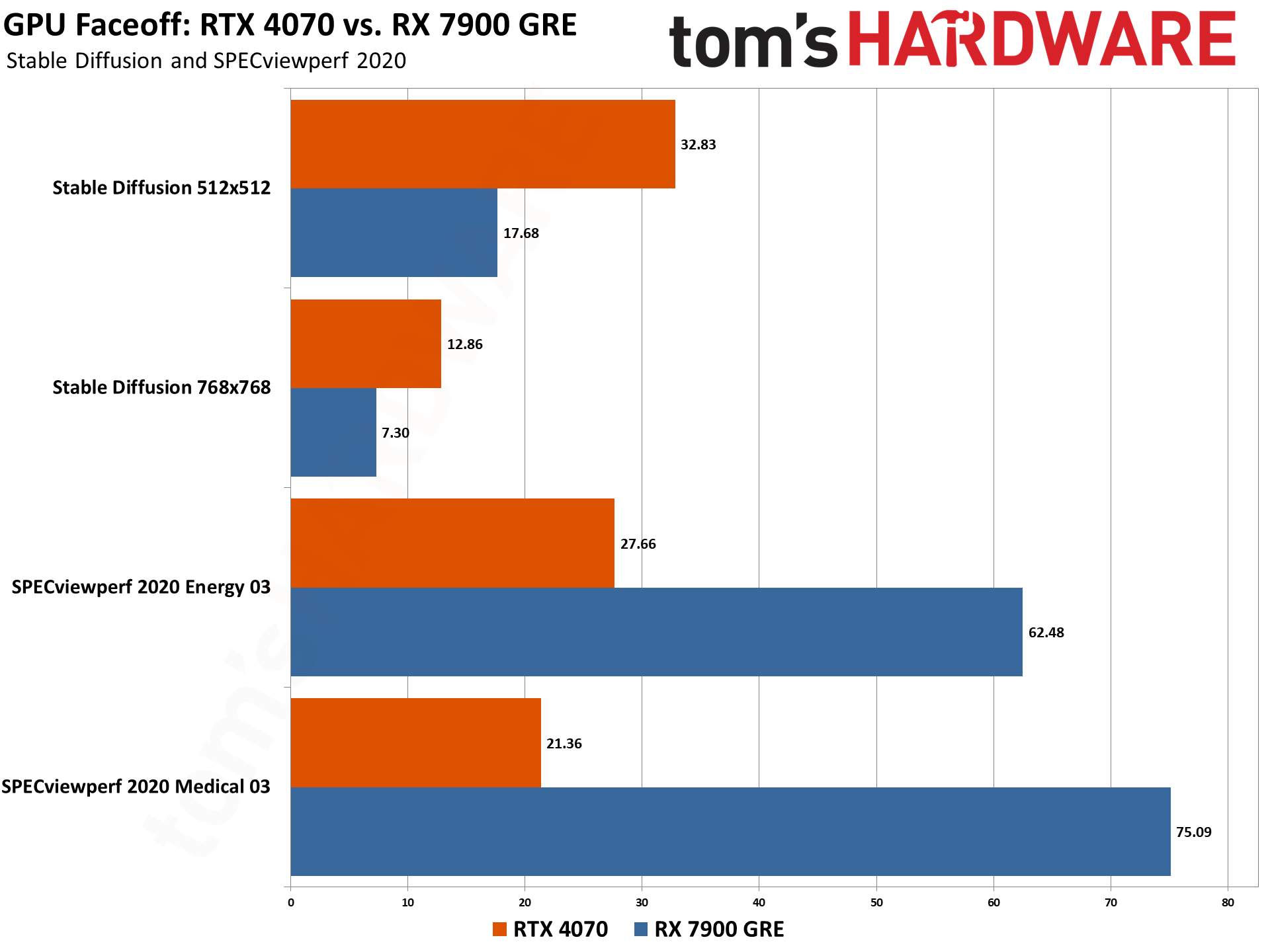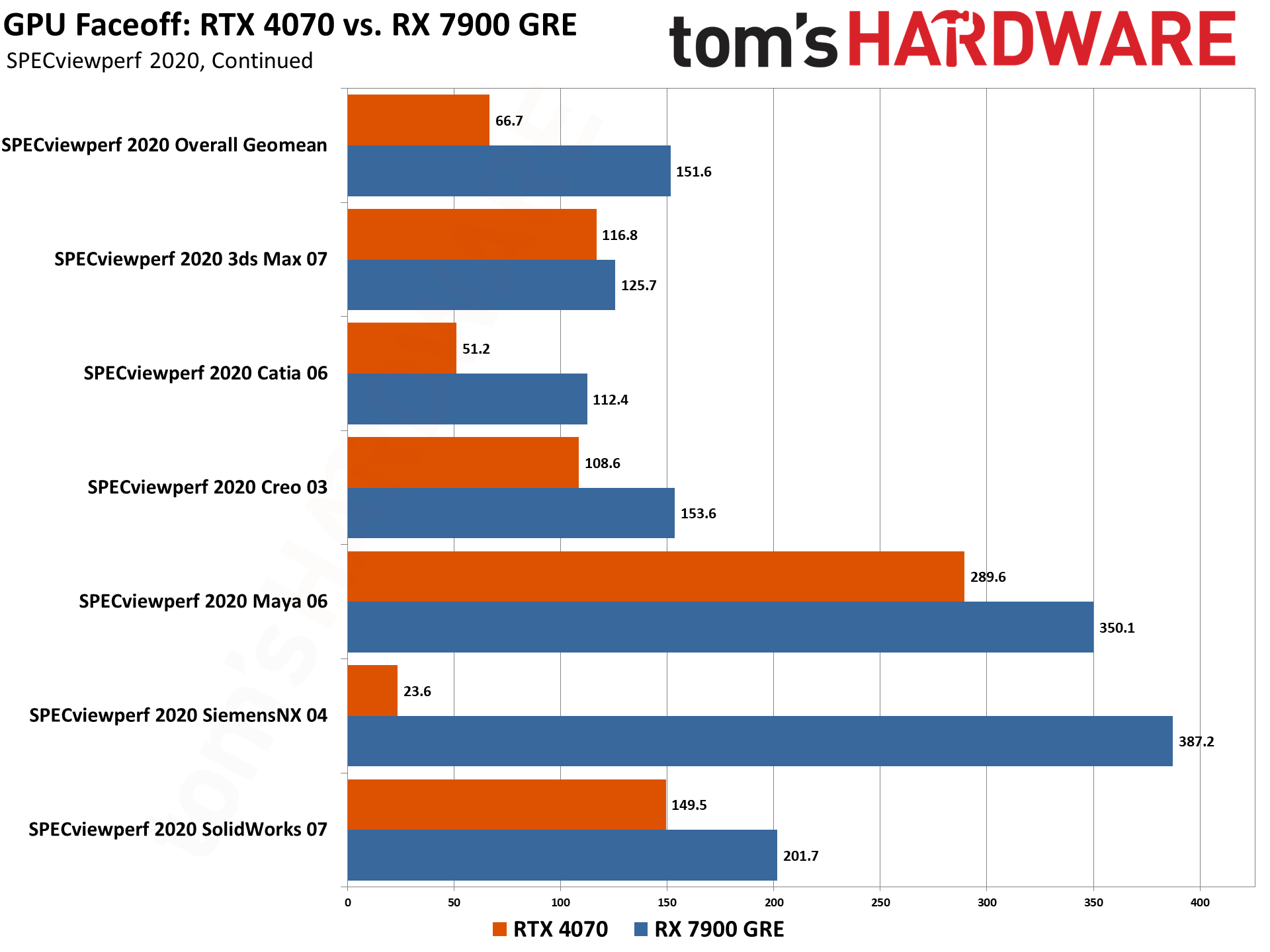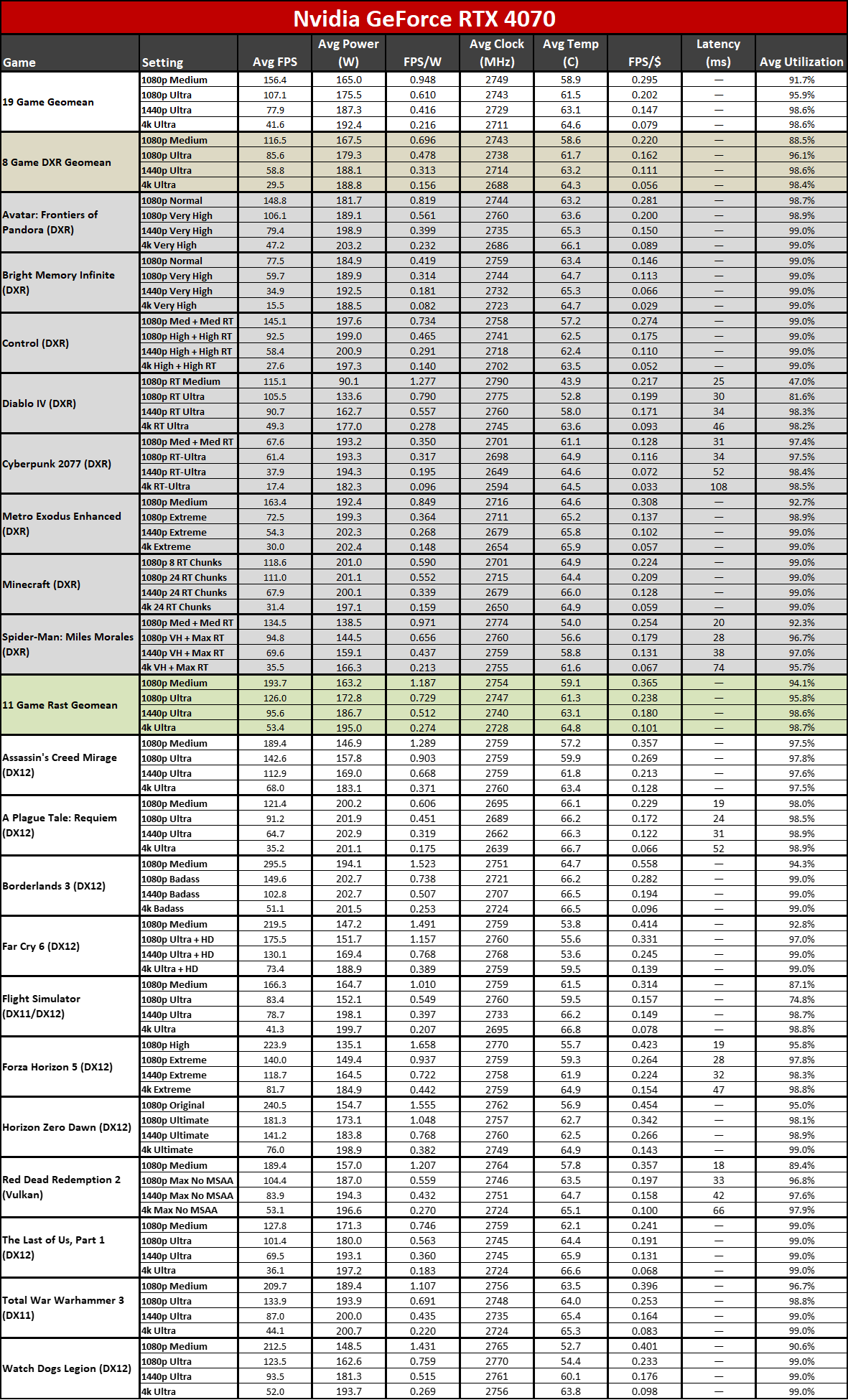This GPU faceoff between AMD’s RX 7900 GRE (Golden Rabbit Edition) and Nvidia’s RTX 4070 takes a look at one of the most interesting GPU segments. Originally released as a China-exclusive GPU, the 7900 GRE is now available internationally at virtually identical pricing to the RTX 4070, and both rank among thebest graphics cards, making comparisons between these two GPUs an important look at how the two GPU behemoths compete.Since its international debut, theRX 7900 GREreceived a price cut from$649down to $549, putting it in direct competition with theRTX 4070. The 4070 now goes for $520-$550 after receiving a price cut, following the launch of theRTX 4070 Superat the $600 price point.Both GPUs are great competitors in the $500~$600 price bracket, which represent the modern mainstream/midrange graphics card market. For this GPU faceoff, we’ll look at how the RX 7900 GRE and RTX 4070 handle gaming at1080p,1440p, and4Kresolutions, along with other performance aspects like AI and professional workloads. We’ll also check out other factors including power efficiency, features, technology, pricing, and overall value.
RTX 4070 vs. RX 7900 GRE: Performance
As far as AI/professional benchmarks are concerned, the RTX 4070 destroys the RX 7900 GRE in Stable diffusion and Blender. It’s nearly twice as fast as the Golden Rabbit for Stable Diffusion — in both 768x768 and 512x512 image generation. Blender has the Nvidia GPU more than doubling the performance of the 7900 GRE as well. There are other professional rendering applications as well that don’t even attempt to support AMD’s GPUs — V-Ray and Octane, specifically — so that it’s not even remotely close. 3D rendering and AI are both strong suits for Nvidia GPUs.On the other hand, if you’re hoping to do professional CAD/CAM work or certain other professional tasks, AMD tends to be far more generous with driver optimizations there. The 7900 GRE easily defeats the 4070 in SPECviewperf 2020 v3, with an overall (unofficial) score that’s 127% higher. That comes down to the individual test results (not shown), where Siemens NX in particular does very poorly on Nvidia’s non-professional GPUs.These benchmarks — AI, 3D rendering, and professional — aren’t nearly as important for consumer GPUs, so these charts are more a side note than a primary consideration. If you do care about any of them, weight your own decision accordingly.Performance Winner: TieOverall, it’s a close battle between these two GPUs. The gaming performance gap is less than 5% even at 4K — it’s generally less at 1440p and 1080p. If you only care about native rasterization performance, AMD gets a clear win here, but ray tracing in games continues to become more prevalent and Nvidia has strong AI performance as well. We also have to consider upscaling, where DLSS is more widely supported and delivers better image quality than FSR 2/3. Factoring all of those things, we can only conclude that across a wide selection of games, both GPUs deliver a similar experience and are a great choice for 1440p gaming.
RTX 4070 vs. RX 7900 GRE: Price
Pricing between the RTX 4070 and RX 7900 GRE is practically identical at this point in time. If you want to get super technical the RTX 4070, can be had for $10 cheaper at the time of writing, though that also requires the selection of a dual-fan card. We can’t really get too excited about a $10 difference on a $500+ graphics card.The RTX 4070 got a significant price cut when the RTX 4070 Super launched, dropping from the $550–$600 range down to the $530–$550 range. For most people, the RX 7900 GRE was only ever readily available at its $549 U.S. launch price — conversions from Chinese Yuan to USD suggest it got a $100 price cut, but shipping and handling never made sense when the card was a China exclusive.Price Winner: TieConsidering this is a highly contested market segment, it’s not surprising that both AMD and Nvidia deliver a similar overall value and experience. There’s been some fluctuation over time, with official and unofficial price cuts giving one or the other company a short-lived advantage, but it’s difficult to argue against either card.
RTX 4070 vs. RX 7900 GRE: Features, Technology, and Software
Nvidia and AMD both have relatively similar sounding features and technology, and the respective software has evolved over the years to being comparable as well. However, Nvidia has the edge over AMD when it comes to introducing bleeding-edge technologies first, likeG-Sync,hardware-accelerated RT, GPU-accelerated image upscaling viaDLSS, AI tools likeChatRTX, and more. AMD normally comes up with a decently competitive alternative for most of Nvidia’s tech, and its solutions are often open-source and will run on non-AMD GPUs. Perhaps that’s because AMD has to make open-source alternatives if it wants them to be used, though the console factor does muddy the waters.Great examples of the above areFSR,FSR 2.0, andFSR 3.0, and AMDFreeSync technology. Nvidia’s solutions came first and work great if you have the required hardware, but AMD’s solutions work on basically everything. FreeSync for example is arguably the superior option these days, withG-Sync Compatiblebasically capitulating to the inevitable. There are far more FreeSync than G-Sync displays today, and while Nvidia tends to do a better job at certifying which displays work well with its adaptive refresh rate technology, most gamers don’t like getting bogged down in the details. you may use FreeSync monitors with AMD and Nvidia GPUs, but if you buy a G-Sync display, you’re basically locked into Nvidia hardware until you upgrade your monitor.While FreeSync ultimately represents an AMD win, AMD’s other technologies are generally less capable or less mature than Nvidia’s competing technologies. FSR has never been able to compete withDLSSwhen it comes to image quality, and even trails XeSS in that area. AMD Anti-Lag+ had to be pulled back completely due toanti-cheat issues, where Nvidia Reflex has been integrated by the game developers in far more games.AMD is also less capable on the ray-tracing front, which is seeing more adoption these days. Nvidia brought RT to market first and has basically doubled the RT throughput of the hardware in each succeeding generation. For the most demanding RT games, AMD’s fastest RX 7900 XTX basically matches the previous generation RTX 3080 10GB.
RTX 4070 vs. RX 7900 GRE: Power Efficiency
The first two categories were a close battle, but the RTX 4070 easily wins in the power and efficiency category. Nvidia’s Ada Lovelace GPU pulls about 65W–80W less power on average, at each tested resolution, than AMD’s RX 7900 GRE. In our 19-game geomean calculation, the RTX 4070 lands at 175W–192W at ultra settings, while the RX 7900 sucks down 250W–265W.Factor in performance, which was similar as noted above, and the RTX 4070 gets 0.610 fps per Watt at 1080p ultra compared to the RX 7900 GRE’s 0.431 FPS/W. That gives the Nvidia GPU a 42% advantage in overall efficiency. Things don’t change much at 1440p ultra, where the 4070 is still 37% more efficient.Nvidia delivered some major improvements in power use and efficiency with the Ada Lovelace architecture, particularly when not looking at the RTX 4090. Much of the boost comes from moving from Samsung’s 8N process node to TSMC’s 4N node, but other architectural changes also factor in.In contrast, AMD didn’t improve efficiency much at all when looking at RDNA 3 versus RDNA 2. The biggest change was the move to a chiplet architecture on the larger GPUs, which was a cost saving measure rather than a way to improve performance or efficiency. The RX 7900 GRE actually rates as decently power-efficient, with the best FPS/W rating at 1080p out of all RDNA3 GPUs, but the RX 7900 XT and 7900 XTX pull ahead at 1440p and 4K, respectively.Power and efficiency also have a knock-on effect with other aspects of a GPU, like the design of the cards. Nvidia makes a reference RTX 4070 Founders Edition, which uses two 8-pin connectors and a 16-pin adapter. It’s a relatively compact dual-fan, dual-slot card, but there are plenty of third-party 4070 cards that use a single 8-pin connector. There are dual-fan 7900 GRE cards as well, like theAsus DualandAcer Nitro, but those are both 2.5-slot designs and all of the 7900 GRE cards need dual 8-pin adapters. That might make a difference to some users — and note that the top image has the cards relatively to scale, showing just how much larger some of the custom designs can be compared to Nvidia’s reference card.Power Efficiency Winner: NvidiaPower consumption and efficiency aren’t a critical consideration for most gamers, which is why this is our fourth category. However, all other things being equal, we’d much rather have a GPU consuming 70W less power. Less power means less heat and typically less noise from your PC — all good things. Lower power use also opens the door for smaller dual-slot, dual-fan solutions and even mini-ITX card designs. Many RTX 4070 cards also come with a single 8-pin connector, while most RX 7900 GRE cards require two 8-pin connectors. The RTX 4070 ends up as a better option for upgrading older PCs with smaller power supplies.
Get Tom’s Hardware’s best news and in-depth reviews, straight to your inbox.
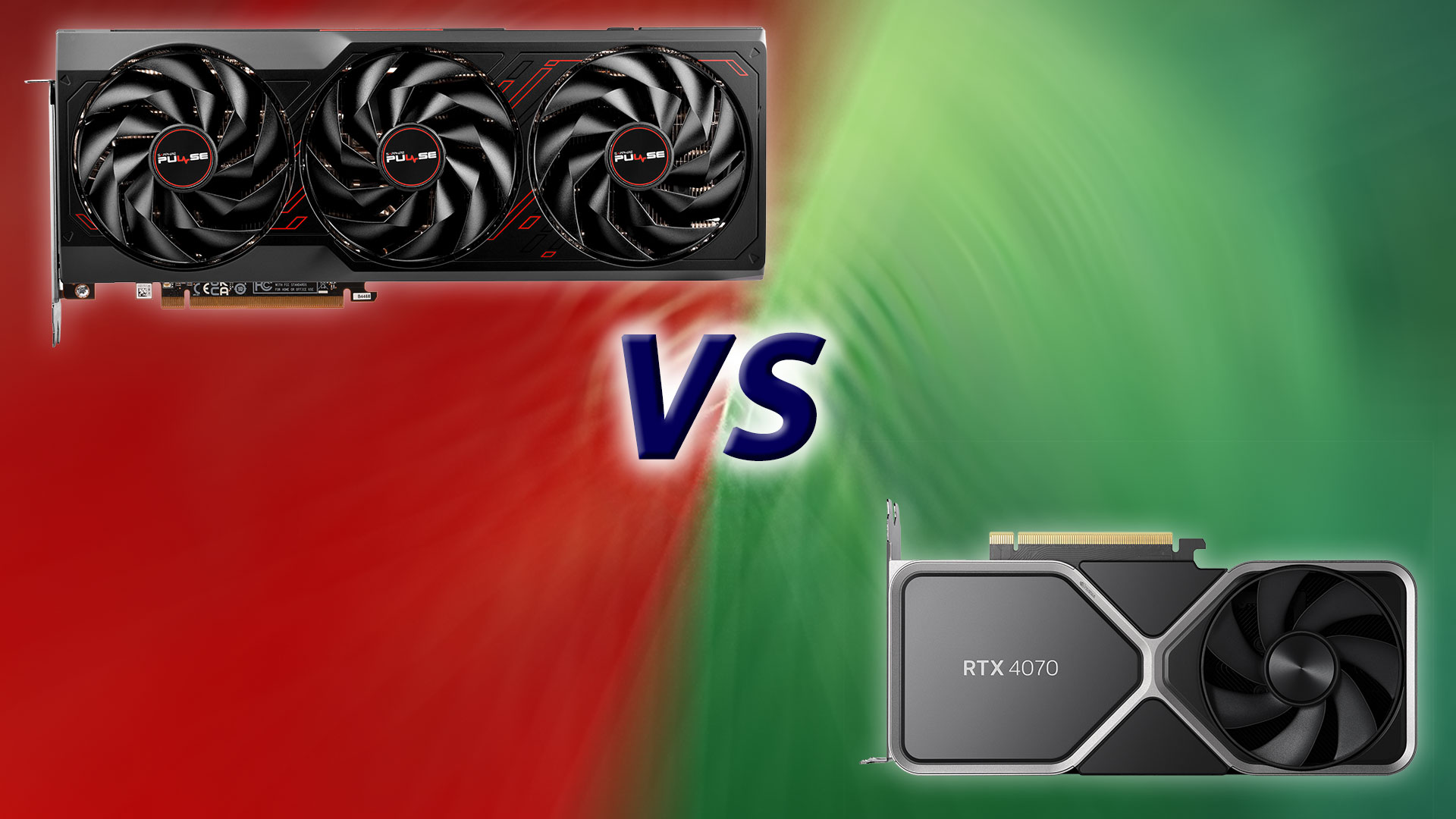
RTX 4070 vs. RX 7900 GRE Verdict
It was a close fight, but in the end the Nvidia RTX 4070 wins. These GPU faceoffs aren’t just about raw performance or any other single category, but rather an overall impression of the cards. We factor in all aspects, from performance to features to technology and more. Gamers looking for the best all around experience will find the RTX 4070 ends up technically superior to the 7900 GRE, with a more versatile set of features and lower power consumption, all while providing similar baseline performance.That doesn’t mean the RX 7900 GRE is a bad graphics card, and in fact it’s one of AMD’s top offerings right now. It’s interesting that AMD waited to launch such a compelling option until it had basically cleared out all the previous generation hardware, and the 7900 GRE definitely gets the nod over the slightly cheaper RX 7800 XT. If you reallyonlycare about raw rasterization performance, or VRAM capacity, the RX 7900 GRE can even be the better option — you just have to ignore a lot of extra qualifications, like ray tracing, DLSS, and AI.The RTX 4070 represents the better product overall. Does the RTX 4070 suit everybody? No. Would an RX 7900 GRE be better for gamers who don’t use ray-tracing, AI, or Nvidia’s feature set? Probably yes. This comparison feels similar to theXbox Series XandPlayStation 5consoles. The Xbox Series X is technically the faster console, but the PlayStation 5 far outsells it due to the PlayStation ecosystem and all of the games you can play onSony’s console. In this case, the RX 7900 GRE may be the technically faster GPU in specific games, but the RTX 4070 offers a better ecosystem of hardware and software technologies.
More GPU Faceoffs
▪GeForce RTX 4070 vs Radeon RX 6950 XT: Which GPU Is Better?
▪GeForce GTX 1650 Super vs Radeon RX 6500 XT: Sub-$200 GPU Face-Off
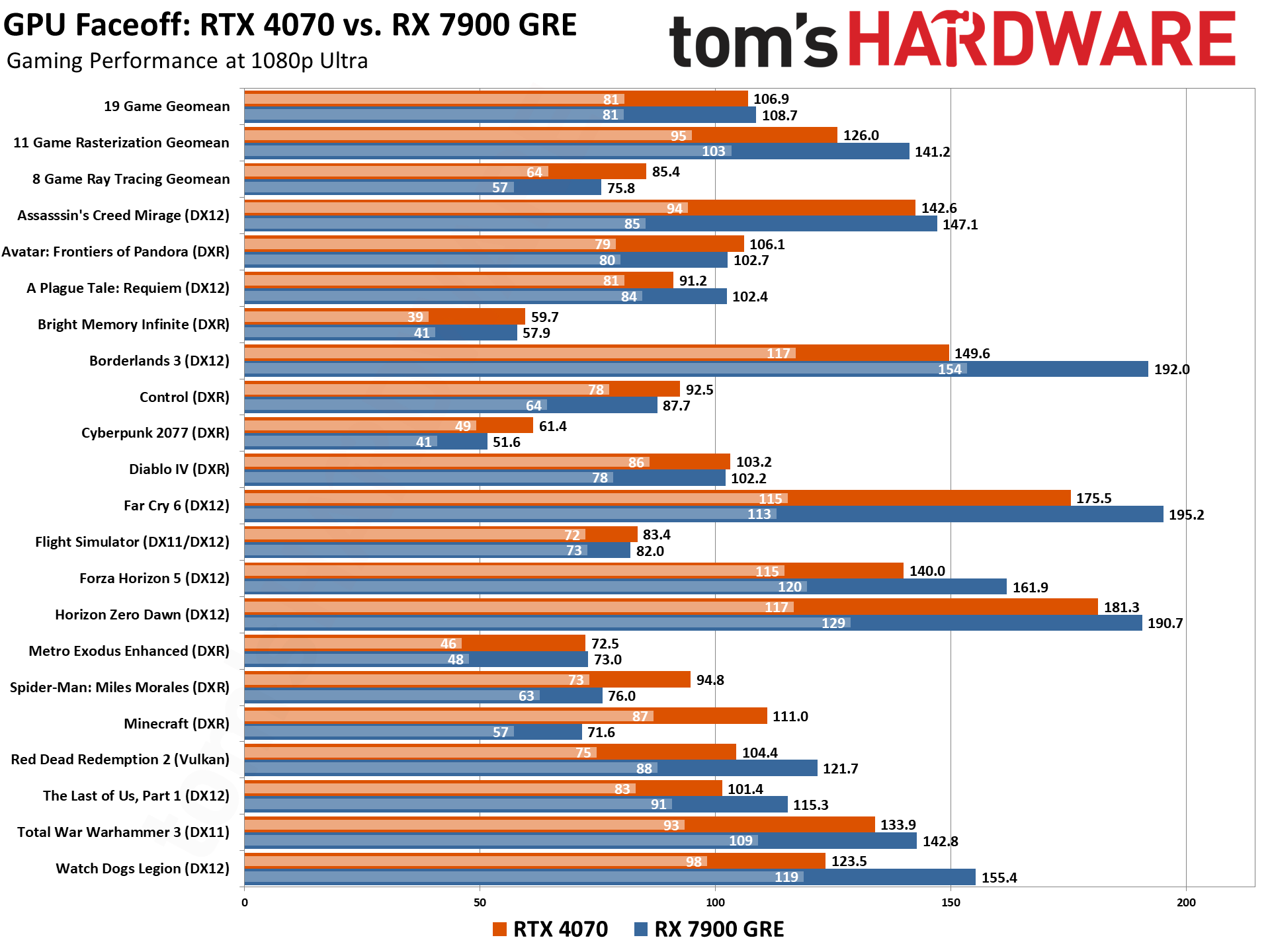
▪AMD vs Nvidia: Who Makes the Best GPUs?
Aaron Klotz is a contributing writer for Tom’s Hardware, covering news related to computer hardware such as CPUs, and graphics cards.
